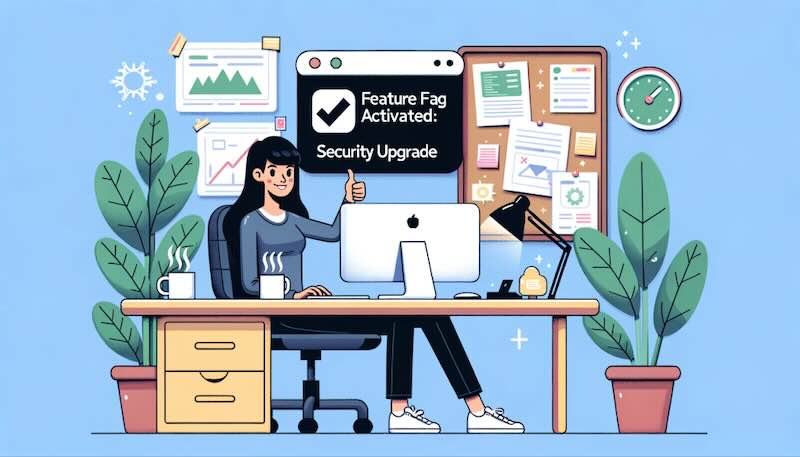Feature Flagging for Security - Best Practices and Use Cases
The rapid pace of software development and the need to continuously deliver new features to stay competitive in today's market has introduced a unique set of challenges, one of which is security. With more and more software applications coming to play a pivotal role in user's daily lives, ensuring the security of these applications is paramount.
Security has become increasingly important for businesses and organizations of all sizes, especially in today's ever-evolving landscape, where cyber threats constantly loom around the corners like shadowy specters. As software systems become increasingly complex and cyberattacks become more prevalent, organizations need effective strategies and tools to bolster their security posture.
The question arising then is: How can they strike a harmonious balance between ensuring the security of their applications and meeting the relentless demand for innovation? One such tool that has gained prominence is feature flagging, and in this blog post, we'll examine how we can utilize it to enhance security while following best practices.

Overview of Feature Flagging For Security
At its core, a feature flag is a snippet of logic code, often termed feature toggles, switches, or flippers, which serves to activate or deactivate features or code segments. Imagine having the power to control specific code within your application, even after it's in production. Feature flagging provides precisely this capability, but it's not just about controlling code; this foundational aspect of feature management empowers teams to decouple deployment from release, thus enabling confident feature rollouts.
Its primary uses include:
- Simplifying release or rollback of features.
- Methodical feature introduction to specific user groups.
- Restricting feature variations to select users or groups.
- Orchestrating controlled experiments on new features.
- Collecting quantitative user feedback.
Feature flags, conceived initially as a method to toggle features on and off during development, have evolved into a formidable shield that can be used to protect your software against possible vulnerabilities and reduce exposure to potential exploits or bugs. This transformative power lies in its ability to test new features in production and make patches with the utmost precision without exposing your entire users to possible bugs or vulnerabilities.
With the power to selectively turn features on or off at runtime, feature flagging equips you with the agility to respond swiftly to emerging security threats in features or updates, minimizing the surface radius of issues and preserving the sanctity of your users by playing the vital role in bolstering and fortifying your application's security.
Best Practices for Implementing Feature Flags for Security
Feature flags are invaluable assets for granting a greater degree of control over software releases and simplifying the introduction and evaluation of new functionalities. However, without adhering to certain best practices, they can easily create disorder instead of the desired clarity.
Planning and Designing Feature Flags for Security
 Effective feature flagging necessitates adherence to certain best practices when planning and designing them. Some pivotal best practices to follow are:
Effective feature flagging necessitates adherence to certain best practices when planning and designing them. Some pivotal best practices to follow are:
- Identify the Type of Flag You Want: It is crucial to understand what type of flag you want to create and what it is for when planning and implementing feature flags. The management strategy for a flag is contingent on its type and purpose. Flags could be short-term (for a specific release, to be removed post-use), permanent (long-term, like for customization or permission-based flags, necessitating meticulous management), or experiment flags (for feature trials and A/B Testing).
- Descriptive Flag Naming Convention: Coherent, descriptive flag names, consistent naming conventions, and well-documented naming rules are pivotal to minimizing confusion and mistakes.
- Integrating Flag Planning in Feature Planning: Integrating feature flag planning within the feature design phase is essential. This helps define the scope of a feature flag and aids in limiting its functionality to trigger a precise action, averting unintended consequences.
- Creation Process Standardization: Streamlining the flag creation process facilitates better tracking and expedites internal procedures. This encompasses consistent naming conventions, tagging, old flag deletions, audit trails or logs, and role-based access controls to mitigate risks from unauthorized access.
- Regular Reviews and Cleanup: Routine reviews and pruning obsolete or unused flags from the code are fundamental to preventing technical debt accumulation.
- Rollback Mechanism: Ensure flags have backward compatible safeguards against potential functionality loss and provide a fallback for engineers, like a kill switch, in case of any issues with new releases or version updates.
- Resiliency: Planning for resiliency is critical to ensure that the feature flag system remains operational even under adverse conditions, like network connectivity issues. Having fallback mechanisms, such as hardcoded defaults and caching evaluations, can help maintain functionality even when there are connectivity issues with the feature flag management system.
Efficient Management and Control of Feature Flags
The management of feature flags is crucial, and a lackadaisical approach could lead to chaos, especially as the scale of operations expands. Some detrimental outcomes of poor feature flag management include the accrual of technical debt, overly complex code, coordination hurdles within teams, and a possible aversion towards using feature flags altogether.
- **Consistent Central Management:**A consistent system for managing feature flags is essential for maintaining an organized and understandable codebase. This might be done through specialized platforms like ConfigCat, which provides a centralized dashboard, or through more straightforward means like a configuration file. Using a centralized management system allows for better control over feature flags, who has access to them, and how they are modified, improving the overall security of operations.
- Audit Trails: Have an audit log to record all changes made to each feature flag, including who made the changes and when, which is critical for accountability and transparency in organizations. Some feature flag management solutions provide audit log capabilities, which can be crucial for tracking changes.
- **Review/Approval Process:**Consider implementing a review and approval process for any flag change requests to ensure that only authorized changes are made, preventing unauthorized alterations.
- Client-Side Code Considerations: Keep client-side feature flags short-lived and ensure they do not control critical functionality. When feature flags are implemented in client-side code, it's crucial to adopt general security practices since this code can be viewed and potentially altered by malicious actors.
Monitoring and Evaluating the Impact of Feature Flags on Security
Employ real-time monitoring and reporting on flag usage to analyze the effectiveness and long-term effects of feature flags, which can be especially helpful for monitoring user engagement and behavior and pinpointing potential areas for application improvement. Utilize tools like Datadog for feature flag tracking to provide visibility into application performance and user experience, helping to release new features safely and reliably.
The outlined practices involve a comprehensive approach toward planning, managing, and evaluating feature flags in a security-conscious manner. By adhering to these practices, organizations can significantly mitigate the risks associated with feature flags and protect their software by ensuring a robust and secure implementation.
Use Cases for Feature Flagging for Security
 Feature flags can be instrumental in improving security for your applications and systems. Here's a detailed breakdown of how feature flags can be utilized to bolster security:
Feature flags can be instrumental in improving security for your applications and systems. Here's a detailed breakdown of how feature flags can be utilized to bolster security:
Toggling Access to Sensitive Data
In most applications, sensitive data such as user's data should be protected against unauthorized access. In light of the increasing focus on privacy and compliance (think GDPR, CCPA, etc.), there's a critical need to be able to control access to sensitive data dynamically. Feature flags can act as switches to turn on or off access to such data without requiring a new deployment. With feature flags, you can implement highly adaptable control mechanisms to determine who has access to sensitive data based on their role within the organization or application.
Consequently, only authorized personnel are able to access these sensitive data, reducing the risk of data breaches or leaks. In case vulnerabilities are discovered, feature flags provide the ability to immediately turn off access to these sensitive data or disable the entire feature, preventing further exposure.
Restricting or Enabling Certain User Roles and Permissions
Applications often need various user roles and permissions, each with different access levels to features and data. Feature flags can be used to grant or revoke specific permissions for certain user groups or structure permission levels and restrict access to specific users based on their roles or varying security requirements, allowing for dynamic role-based access control. For example, access to sensitive data or administrative functions can be controlled via feature flags, ensuring that only authorized users can access them.
Furthermore, in a multi-tenant organization, feature flagging can be used to achieve a high level of isolation between different aspects of your business, including various business domains, business concepts, application users, and internal teams or departments. Each tenant or group within the organization can have its own customized feature set and access controls, ensuring their data and operations are kept separate and secure.
Incremental Release of Security-Critical Features
When rolling out features critical to an application's security (e.g., a new authentication mechanism), it's essential to ensure that they work as expected and don't introduce new vulnerabilities. Feature flags allow these features to be released incrementally. For example, targeted rollouts, starting with internal users, then a percentage of real users, gradually increasing the exposure.
Initially, security-critical features can be hidden behind these feature flags, allowing developers to thoroughly test them in a controlled environment. This approach minimizes the risk of introducing new vulnerabilities or causing disruptions in the production environment. Feature flags also provide a rollback mechanism. If a critical issue is discovered post-release, you can immediately disable the feature without having to redeploy the entire application.
Conclusion
As organizations strive to safeguard user's sensitive data and fortify their defenses against evolving threats, feature flagging serves as a potent tool that offers granular control over feature deployment, controlled experimentation, dynamic access control to sensitive data, and the incremental rollout of security-critical features, which together contribute to a fortified security posture without stifling the pace of innovation.
By adhering to meticulous planning, standardized creation processes, and efficient management practices, organizations can exploit feature flags' full spectrum of benefits. Through a judicious integration of feature flagging in the software development lifecycle, organizations can not only navigate the treacherous waters of cybersecurity but also foster a conducive environment for continuous delivery and user-centric innovation.
ConfigCat supports simple feature toggles, user segmentation, and A/B testing and has a generous free tier for low-volume use cases or those just starting out.
For more feature flagging goodies, stay connected to ConfigCat on X, Facebook, LinkedIn, and GitHub.
